“I’m going on a trip, and I’m bringing” is my take on “whats in my camera bag”,
because I think there are few photographers who only have one bag or backpack, or am I the only bag hoarder here ? 🙂
Certainly, it’s always possible, and in reality, we only require one or maybe two bags. The challenge, at least in my experience, and as I’ve come across in many others, is that the bag tends to be either too small or too large, not conveniently designed, lacking the versatility of being a shoulder bag or a backpack, and so on. Resulting in the purchase of more or other bags.
The type of photography we engage in plays a significant role as well, be it street photography, macro… Many photographers are content with just a camera and one or two lenses, in such cases, a bag isn’t always necessary. Conversely, macro photographers often carry an extensive range of equipment, making a roomy bag a practical choice.
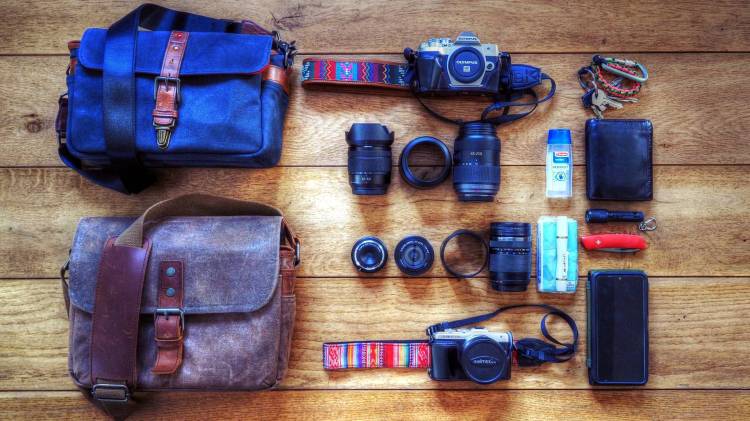
The Bag :
ONA Bag The Bowery for Leica – 27x18x10cm – average price €200
Berchirly Canvas Bag MB1022 – 30x20x11cm – average price €35
I possess a pair of smaller bags: an inexpensive one, the (Berchirly Canvas Bag MB1022) and a considerably pricey one (ONA Bag The Bowery for Leica).
The latter was given to me free upon buying a second hand camera.
I opt for the compact bag when I don’t have a particular photography objective in mind—whether it’s wandering through the city, hiking in the woods, attending a family gathering, etc. A kind of “every day bag”.
One camera, perhaps an additional lens, a spare battery, and personal things.
The decision between the two bags depends on what needs to be taken along; the ONA bag is slightly smaller.
In my opinion, asking for €200 for a small bag seems like a bit of an exaggeration, and I personally wouldn’t make such a purchase. However, there’s a wide range of similar options available in the market. These messenger-style bags are highly popular, capable of accommodating various items beyond just your camera gear – think wallet, keys, smartphone, and in many cases, even a small tablet or iPad. Naturally, there are alternative compact and practical bag designs, including small backpacks. Something suitable can be found for everyone’s needs.
One more point to mention: all the bags I opt for have a “natural” essence, which translates to materials like canvas, cotton, and leather. This stands in contrast to the conventional synthetic, black camera bags made of nylon or similar materials. This preference is purely because of my personal liking, not necessarily to disguise the bags as non-camera-related items, although this misconception is occasionally associated with these particular bag types. Of course, a potential thief is aware of this fact too. So, what do you suppose a thief might assume when they spot a “non-camera bag-like” item being carried, while you conspicuously hold a high-priced camera ? I’m inclined to believe that the advantages of avoiding the camera bag appearance hold very little weight.
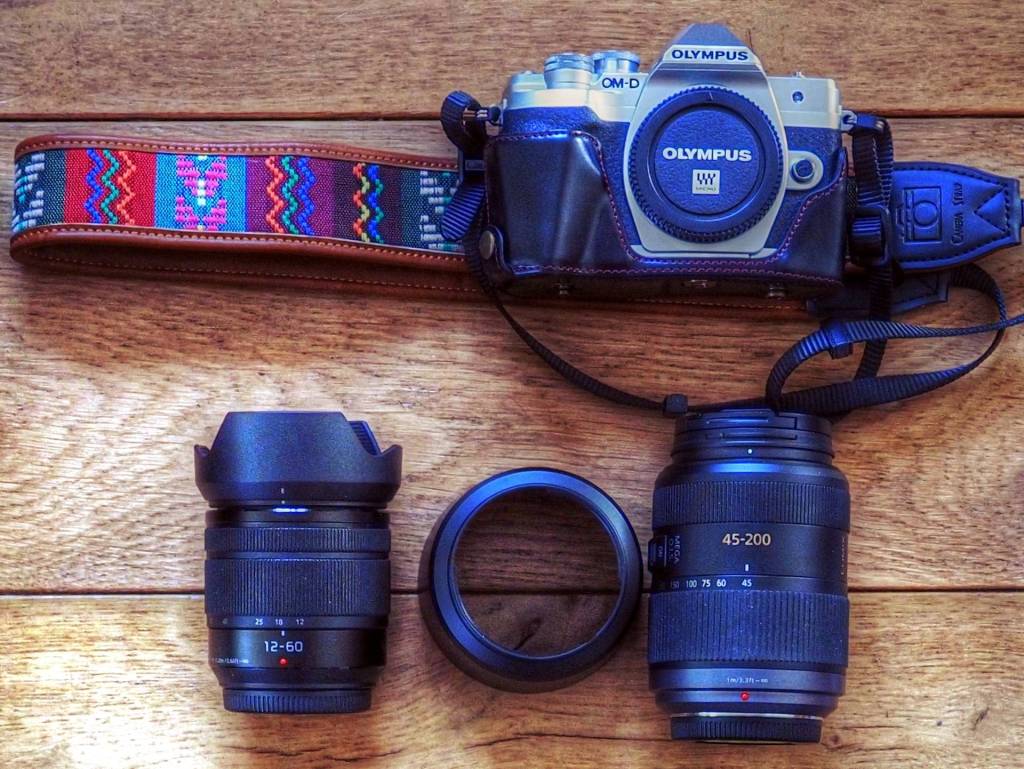
The Camera :
Olympus OM-D E-M10 Mark IV body – average price €550 or less second-hand
For my casual outings, I rely on the Olympus E-M10 Mark IV camera. It holds the distinction of being the tiniest and lightest within the Olympus series, exuding a charming old-school camera vibe. Its compact dimensions make it discreet, allowing easy street photography or capturing moments in bustling locations, which is the primary reason for my choice. This camera boasts a 20MP resolution but lacks weather sealing. I decided to upgrade from the E-M10 Mark III, and the Mark IV outperforms it in several aspects. Notably, the electronic shutter is more accessible than the concealed one on the Mark III. In my personal opinion, if your interest lies in photography rather than video, consider either the 16MP Mark II version or the Mark IV.
The Lens(es) :
Usually my go to lens is the Panasonic G vario 12-60 f3.5-5.6 – average price €250 or less second-hand
The Panasonic G Vario 12-60mm f3.5-5.6 lens is truly impressive, particularly due to its slightly extended range compared to the standard lenses commonly found on Olympus and Panasonic cameras. Its range covers a field of view equivalent to 24-120mm. The image quality is generally good, although there’s a minor decrease in sharpness as you zoom towards the telephoto end. What sets this lens apart is the generous 12mm wide-angle, a notable advantage over many similar lenses that typically start at 14mm. The optical performance shines between f5.6 and f8. For me, the 12-60mm lens is a personal favorite due to its lightweight and compact design.
I’m currently utilizing the Panasonic Lumix G Vario 45-200mm f/4.0-f/5.6 MEGA O.I.S (first edition – gold letters) as my secondary lens. It’s a lens that often doesn’t get the recognition it deserves and is frequently labeled as lacking sharpness and speed. Admittedly, the sharpness diminishes as you zoom towards the longer end, but this is a common trait among most zoom lenses, if not all. Its prime performance range lies approximately between 35mm and 100mm, surpassing the capabilities of many 140mm and 150mm lenses. It operates best within the aperture range of f/6.3 to f/8, and its zoom range complements the Panasonic 12-60mm lens seamlessly. The lens is relatively compact and lightweight; it’s the lens hood that gives it a larger appearance, but the hood can be reversed and mounted on the lens, making it convenient for transportation.
A lens that you’ll find almost always packed with any of my gear, and it takes up virtually no space, is the Olympus Fisheye Body Cap 9mm f/8 Lens. This remarkable lens has a thickness of around 12mm and weighs a mere 30 grams. It operates without autofocus (AF), utilizing a focusing lever that doubles as a lens protector, safeguarding it from dust. The lens’s focus can be adjusted, ranging from 20cm to hyperfocal and infinity. The hyperfocal setting is particularly noteworthy, enabling you to effortlessly capture sharply focused images spanning from approximately 1m to infinity, all within an impressive 180° field of view. Furthermore, in software like Rawtherapee, the fisheye distortion can be easily corrected. This lens can prove invaluable in scenarios where an ultra-wide-angle lens is the go-to choice. Think stunning sunsets, expansive landscapes, and captivating architectural shots. The second benefit is that when your camera is fitted with this lens, it becomes incredibly portable, enabling you to discreetly capture photos in locations where cameras are more unwanted, like music performances and festivals, museums etc. Regardless, it’s an essential lens to have.
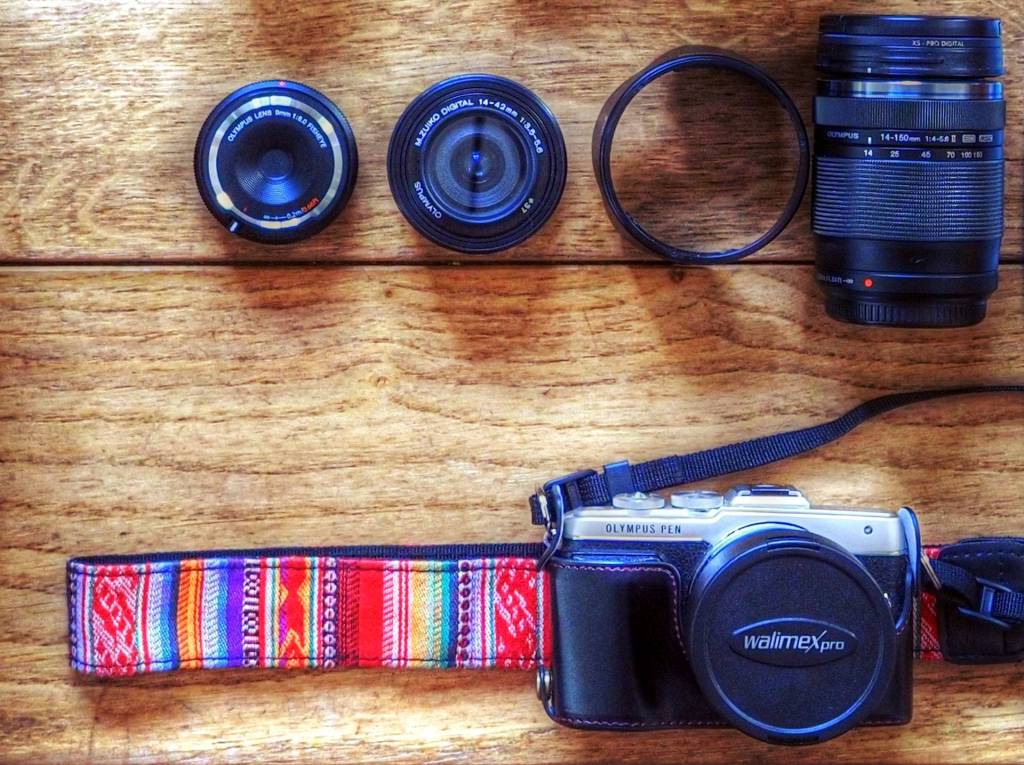
As alternatives to the previously mentioned setup, I occasionally bring along the Olympus E-PL7, which here is paired with the Walimex Pro 7.5mm f/3.5, a rebranded Samyang lens. Another option is the Olympus 14-150mm lens, as well as the Olympus pancake 14-42mm lens. The latter is a versatile lens that I find suitable to carry at all times, as the quality of the photos it produces is quite impressive, and its field of view can be particularly intriguing in certain scenarios. Additionally, on occasions when I’m heading to a wildlife park or similar environments that demand more telephoto capabilities, I include the Panasonic 100-300mm lens as a secondary option.
I initially acquired most of the lenses mentioned above when I took my first steps into the micro 4/3 system and Olympus. Some came as part of a used camera set, while others I purchased individually, almost all as secondhand items. In terms of quality, they can’t compete with the Olympus and Panasonic Pro lenses I later invested in, but these (cheaper) lenses have a distinct advantage: they’re usually much more compact and lightweight compared to their professional counterparts. This characteristic aligns perfectly with the lightweight and compact nature of the m4/3 concept. As time goes on, some lenses from my collection will be replaced, making way for new ones. However, given the previously mentioned benefits, my professional lenses will never completely replace them.
Regarding personal belongings:
Items like house keys, wallet, and smartphone are pretty much standard, but alongside those, I’ve found a compact Swiss army knife and a small flashlight to be consistently practical. You never know when you might find yourself on a nighttime walk. Additionally, carrying hand sanitizer has become a habit since the COVID-19 period. Whenever dining out, it’s always a good idea to disinfect your hands. And having tissue paper on hand is reliably helpful, especially if you’re spending time with your grandchildren. The above items can prove valuable in a range of situations and for diverse objectives. For those interested in preparedness and everyday carry enthusiasts: Combining a compact pocket knife, a flashlight, disinfectant or flammable liquid, and paper tissues creates a mini survival kit that’s perfect for unexpected situations. These days, emergencies can arise anywhere across the globe.
Well, this marked the debut of the “I’m going on a trip, and I’m bringing” series, and given the expansiveness of my camera equipment, there will certainly be a second and third edition, featuring a more comprehensive gear setup and a complete extreme telephoto setup tailored for capturing birds, wildlife, etc.
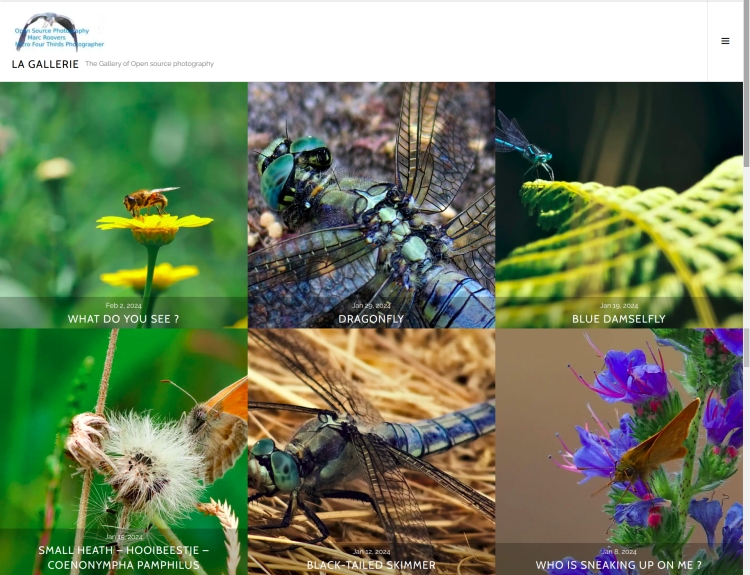
The photo gallery of Open Source Photography, Olympus micro 4/3 system, Vintage Lens Photograpy, Film Simulation, PictureFX, HDR – Photographer : Marc R.

Discover more from Open Source Photography
Subscribe to get the latest posts sent to your email.


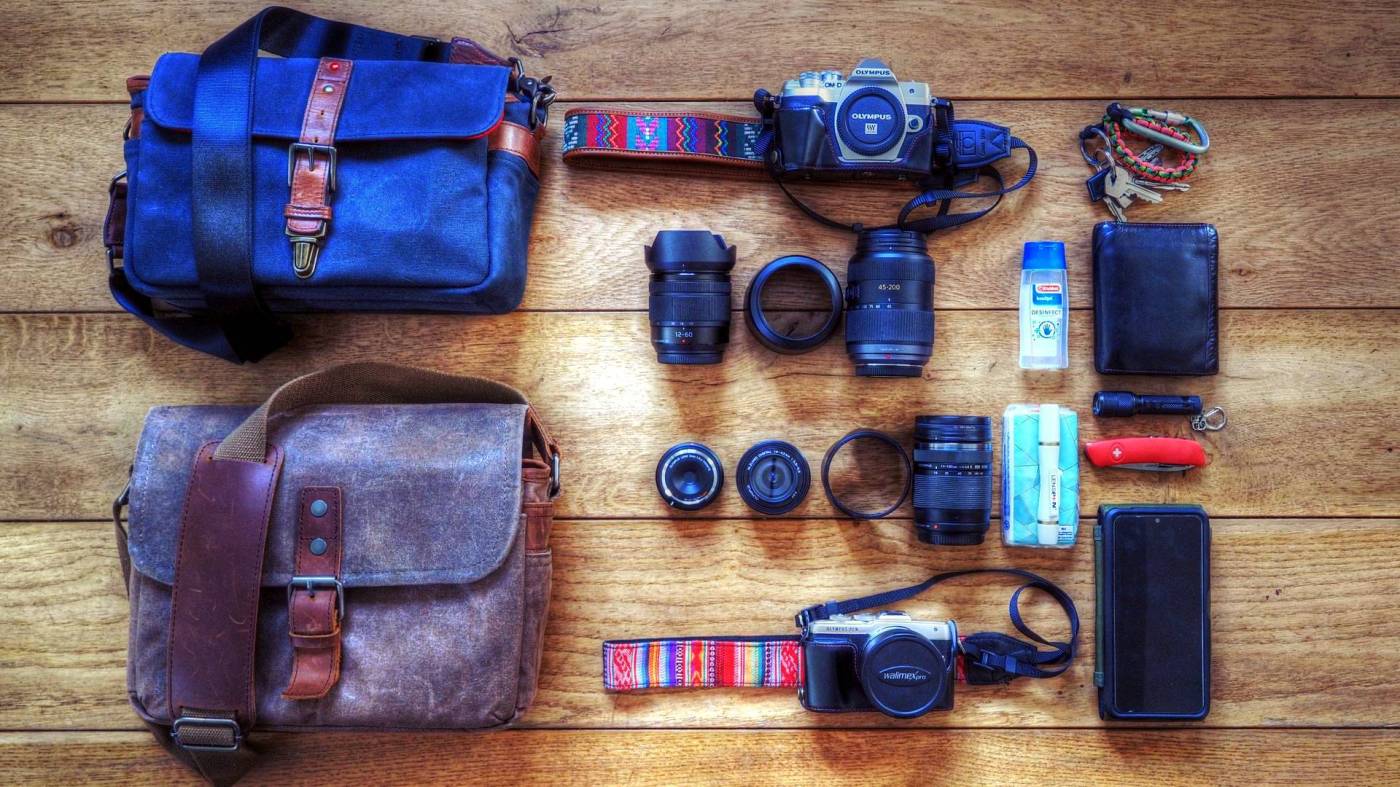

Lovely, I usually take just a single camera and my smallest lens with me on holidays. When I went to Rome and parts of europe, it was a D5200 and 18-105 or X-T20 and 15-45. These days it’s the X-T3 and 23mm. Although, I may take the 16-80 with me next time, even though it’s larger. Lovely write up as always Marc.
LikeLike
I have discovered, rather late, the value of using the correct bag for your needs. We are nature/wildlife photogs and typically use the big (and heavy) long lens. Some times two bodies and mounted lens on a walk in the boonies. Well…a single strap sling most always fit everything. Also had huge stress on the body over the years. Now I know and ‘preach’ proper and minimal bag selections. Basically have choices on hand and work with the minimum gear needed.
LikeLiked by 1 person
Went to an air show yesterday, brought two long lenses and four smaller lenses, way too many batteries and a bunch of stuff I didn’t use. Today everything hurts, back hurts, shoulder hurts …
so I totally understand you.
LikeLiked by 1 person
I’m a slow learner 😁. Full neck fusion, two rods and pins. But I can say for years it was great being out in swamps and marshes like nothing I had ever imagined.😉. My new ‘me’ is taking some getting use to but the ‘dry needle’ therapy and exercise has me up and out slowly. 😁😁
LikeLiked by 1 person
Oh dear ! That doesn’t sound good at all !
LikeLike
We just adapt 🙂
LikeLiked by 1 person